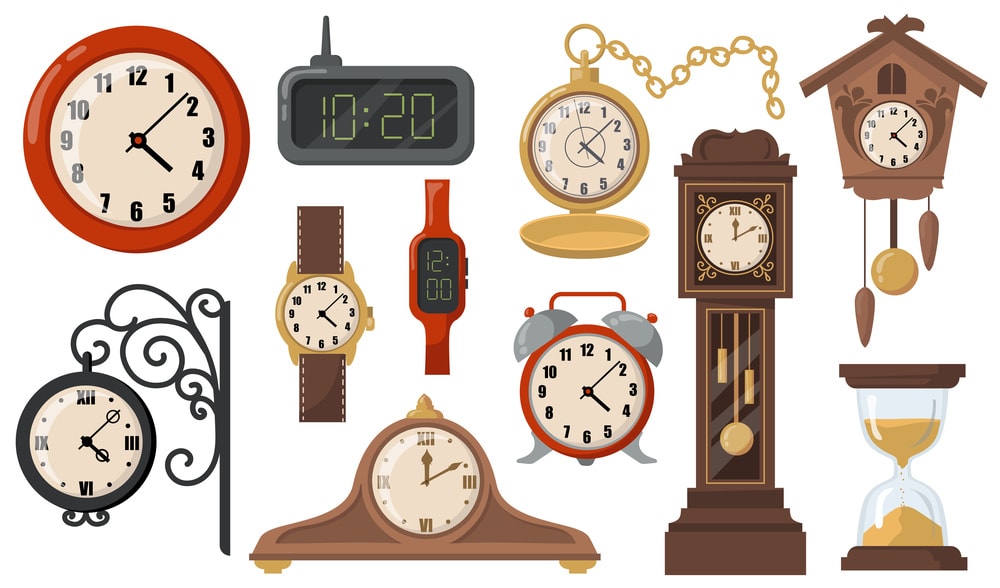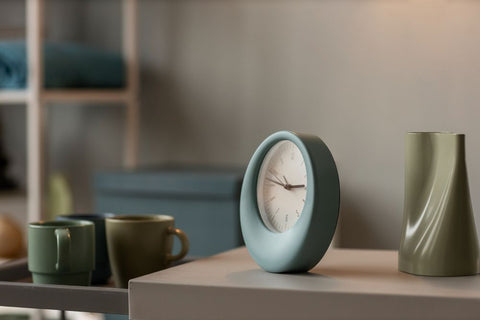From Grandfather Clocks to Smartwatches: A Look at Different Types of Clocks

Time is an essential part of our lives. From the moment we wake up until the time we go to bed, we are always mindful of it. And one of the most important tools to measure time is a clock.
From traditional grandfather clocks to modern-day smartwatches, the world has witnessed a significant transformation in how we track time. But have you ever wondered about the different types of clocks that exist? Let's take a closer look.
Different types of clocks give us lots of options to choose from. Thousands of different clocks are available on the market in any style or design you desire. Hundreds of different clock types are available today in different colors, models, and designs. Each of these models is designed for a specific purpose. We will take you on a 10-minute journey to discover the most iconic clock models. If you're ready, let's begin.
How Many Types of Clocks Are There?
Watch models respond immediately to changes in our social lives, professional lives, or daily needs. Watch models from hourglasses to pendulum clocks to smartwatches have been transformed by this change.

1. Hourglass Clocks
Hourglasses date back to the 8th century. The first hourglass was discovered by a French monk and used to adjust church prayer times. Hourglasses transfer sand or liquid through a narrow passage at the bottom. The decorative version of hourglasses still appears in stores today.

2. Sun Clocks
Sundials are among the earliest types of clocks. It is common to find these clocks in ancient Egyptian and Chinese sources, whose shadow, which reflects the sun's position on the clock, provides the time. However, since the Earth's orbit around the Sun constantly changes, they need to be more accurate.

3. Water Clocks
An Italian water clock in Rome is still running by water. Water clocks rotate the gears with running water. They display the time for 24 hours. Until this day, very few water clocks have survived. It is clear, however, from historical records that they were widely used in Europe and the Middle East.

4. Graduate Candle Clock
Before the invention of electricity, candles were the most common light source. However, it's been centuries since candles were used to count time. Their purpose was to mark a fixed period, providing a steady light source in a protected environment.

5. Obelisks
Ancient Egyptian obelisks reached a height of 30 meters and were not intended for use as timepieces. However, over time, the shadows of these decorative stones became a means for estimating time. With the development of modern clocks, these decorative clocks were transformed into new designs. In the early models, pendulums were used, but later different mechanisms were also used.

6. Pendulum Clocks
The first pendulum clock was developed by Christiaan Huygens in 1656 based on Galileo's pendulum principle. In 1721, George Graham's pendulum clock set a new standard for accuracy, falling behind by only 1 second per day. Once a symbol of social status, these clocks are now used to decorate alongside clocks.

7. Analog Clocks
Analog clocks display time with mechanical systems. Time is displayed by moving hour, minute, and second hands. They are typically powered by batteries or quartz and are seen in clock towers. Analog clocks and their traditional aesthetic appeal continue to be popular.

8. Digital Clocks
As with quartz mechanism clocks, digital clocks operate on an oscillation frequency. In the early 1900s, the first digital clocks were produced with various mechanisms. The first LED digital clock was patented by D.E. Protzmann In 1956; Hamilton Watch Company began mass-producing LED digital clocks in 1970.

9. Atomic Clocks
An atomic clock is a type of clock that uses the resonant frequencies of atoms to measure time. These clocks have an extremely low chance of making a one-second error in three million years, with a likelihood of only 22.522%. By establishing International Atomic Time (IAT), atomic clocks provide a consistent and reliable standard for measuring time. The first atomic clock was developed in 1949 and is still in use today.

10. Quartz Clocks
In 1880, the Curie brothers discovered piezoelectricity, which showed that certain crystals constantly vibrate when compressed. A quartz mechanism can produce a steady vibration by using a battery, and this vibration is then converted into electrical signals to operate the clock mechanism. The first quartz clock mechanism was developed by Seiko in 1969, and now modern clocks rely heavily on this mechanism.

11. Cuckoo Clocks
The cuckoo clock is a traditional wooden clock that is handcrafted in Germany and is typically characterized by a chalet-style or intricately carved façade. The clock is powered by precise weights that drive the internal clockwork. Periodically, a "cuckoo" bird emerges from the clock and sings a tune to announce the hour. Different types of cuckoo clocks are available, including mechanical and quartz clocks, with varying running times.

12. Grandfather Clocks
Typically, a grandfather clock stands over six feet tall and consists of a pendulum and weights enclosed within a tall case. The Roman numerals adorn the clock face, which must be wound every 7 to 10 days. A melodious chime marks the passage of time every fifteen minutes. The clock's design and name are inspired by the image of an older man watching time pass.
13. Wall Clocks
Since the adoption of the first pendulum clocks in the 1550s, wall clocks have been among the most popular decorative items for walls. These clocks have undergone numerous changes over the years, yet they still maintain their status as a necessity today. You can find them in homes, schools, offices, kitchens, and bedrooms; anywhere life is experienced. Nowadays, different types of wall clocks are generally powered by a quartz mechanism that is supported by a battery.

14. Table Clocks
The table clock is an excellent timepiece to have on your desk, bedside table, or anywhere else you need it. Dating back to the 16th and 17th centuries, both desk clocks have undergone many changes over the years. As with many other types of clocks, desk clocks are also equipped with quartz mechanisms today.

15. Desk Clocks
Desk clocks are specifically designed for use on a desk or work area. Unlike larger table clocks, desk clocks are smaller and simpler. As a result, they often contain features especially useful in a work environment, such as a timer or alarm. Additionally, desk clocks are available in various materials, including plastic and metal, allowing them to fit into almost any work environment.

16. Calendar Clock
Calendar clocks gained popularity with George Daniel's perpetual calendar watches, which included additional mechanisms for displaying the day and month. Various mechanisms power these clocks, such as mechanical, electronic, or quartz movements.

17. Alarm Clocks
Alarm clocks are timepieces designed to wake us up at a specific time. They come in many different models, both analog and digital. Some digital alarm clocks have features that allow users to set alarms for specific days and times. These clocks often have multiple alarm settings. With analog clocks, the alarm is set by positioning the alarm indicator to the desired time.

18. Projection Clocks
Some advancements in projection technology have made it possible to apply this technology to clocks. For example, certain electronic devices can project digital or analog clocks onto a flat surface, a wall, or even a ceiling. Ideally, they can project within a range of 2 to 10 meters. In addition, these projectors consume less power than regular projectors, resulting in longer lifetimes.

19. Flip Clocks
A flip clock is a mechanical clock that uses flipping cards to show the time. The clock has cards with printed letters or numbers that flip over to display the current time through a window on the clock's face. The flipping motion generates a unique sound. Originally used in public places, flip clocks are now popular for their retro or vintage look and can be found with modernized features.

20. Radio Clock
Using desk clocks as radios is not a new concept, but nowadays, these clocks often have multiple functions in addition to the radio, such as a thermometer, calendar, and alarm.

21. Countdown Clocks
A countdown clock displays the remaining time until a specific event or time. The clocks count down from minutes to days or even months. Countdown clocks often create excitement and anticipation for special events like holidays, sports events, or product launches.

22. Chronometers
You may think stopwatches measure how long it takes to complete a race course. However, sailors use them the most. For example, they used stopwatches to calculate ship speed. Stopwatches are now commonly found inside digital watches or mobile phones but are also specifically designed for specific purposes.

23. Smartwatches
Sony took the first step in smartwatch development with the launch of their SmartWatch in 2012. This innovation has attracted the attention of several large companies, including Samsung and Apple. Following Apple's entry into the market in 2015, smartwatch development intensified. Smartwatches are synchronized with mobile phones and offer a wide range of features.
24. Time Zone Clock
Initially, tourist hotels used time zone clocks to show the time in guests' home countries at their receptions. However, these clocks were eventually adopted as stylish accessories for homes and workplaces, featuring brass plating and chic designs.

25. Outdoor Retro Clock
Outdoor retro clocks are designed to withstand external conditions such as snow, rain, and sun. In addition, they have waterproof and rust-resistant covers. These clocks are perfect for gardens, building entrances, streets, etc.
Clocks have undergone a constant process of change and evolution until they reach their modern form, reflecting the fast-paced nature of our contemporary world. These valuable instruments have been exchanged as gifts among heads of state and kings in the past, and they still hold importance.
At Mclocks, we strive to approach all our designs with the same mindset as Christiaan Huygens, who created the world's first wall clock. Our goal is to be unique and create functional, original, elegant, and detail-oriented designs.


